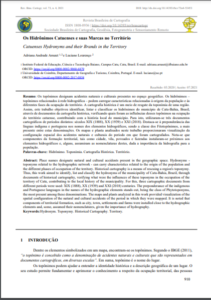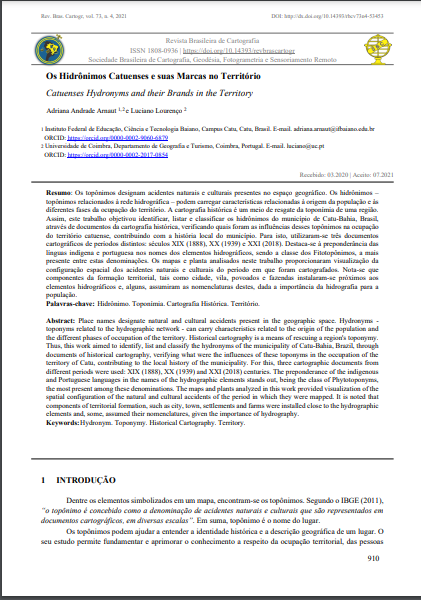Adriana Andrade Arnaut
Luciano Lourenço
Resumo: Os topônimos designam acidentes naturais e culturais presentes no espaço geográfico. Os hidrônimos – topônimos relacionados à rede hidrográfica – podem carregar características relacionadas à origem da população e às diferentes fases da ocupação do território. A cartografia histórica é um meio de resgate da toponímia de uma região. Assim, este trabalho objetivou identificar, listar e classificar os hidrônimos do município de Catu-Bahia, Brasil, através de documentos da cartografia histórica, verificando quais foram as influências desses topônimos na ocupação do território catuense, contribuindo com a história local do município. Para isto, utilizaram-se três documentos cartográficos de períodos distintos: séculos XIX (1888), XX (1939) e XXI (2018). Destaca-se à preponderância das línguas indígena e portuguesa nos nomes dos elementos hidrográficos, sendo a classe dos Fitotopônimos, a mais presente entre estas denominações. Os mapas e planta analisados neste trabalho proporcionaram visualização da configuração espacial dos acidentes naturais e culturais do período em que foram cartografados. Nota-se que componentes da formação territorial, tais como cidade, vila, povoados e fazendas instalaram-se próximos aos elementos hidrográficos e, alguns, assumiram as nomenclaturas destes, dada a importância da hidrografia para a população. Palavras-chave: Hidrônimo. Toponímia. Cartografia Histórica. Território.
Abstract: Place names designate natural and cultural accidents present in the geographic space. Hydronyms – toponyms related to the hydrographic network – can carry characteristics related to the origin of the population and the different phases of occupation of the territory. Historical cartography is a means of rescuing a region’s toponymy. Thus, this work aimed to identify, list and classify the hydronyms of the municipality of Catu-Bahia, Brazil, through documents of historical cartography, verifying what were the influences of these toponyms in the occupation of the territory of Catu, contributing to the local history of the municipality. For this, three cartographic documents from different periods were used: XIX (1888), XX (1939) and XXI (2018) centuries. The preponderance of the indigenous and Portuguese languages in the names of the hydrographic elements stands out, being the class of Phytotoponyms, the most present among these denominations. The maps and plants analyzed in this work provided visualization of the spatial configuration of the natural and cultural accidents of the period in which they were mapped. It is noted that components of territorial formation, such as city, town, settlements and farms were installed close to the hydrographic elements and, some, assumed their nomenclatures, given the importance of hydrography. Keywords:Hydronym. Toponymy. Historical Cartography. Territory.


